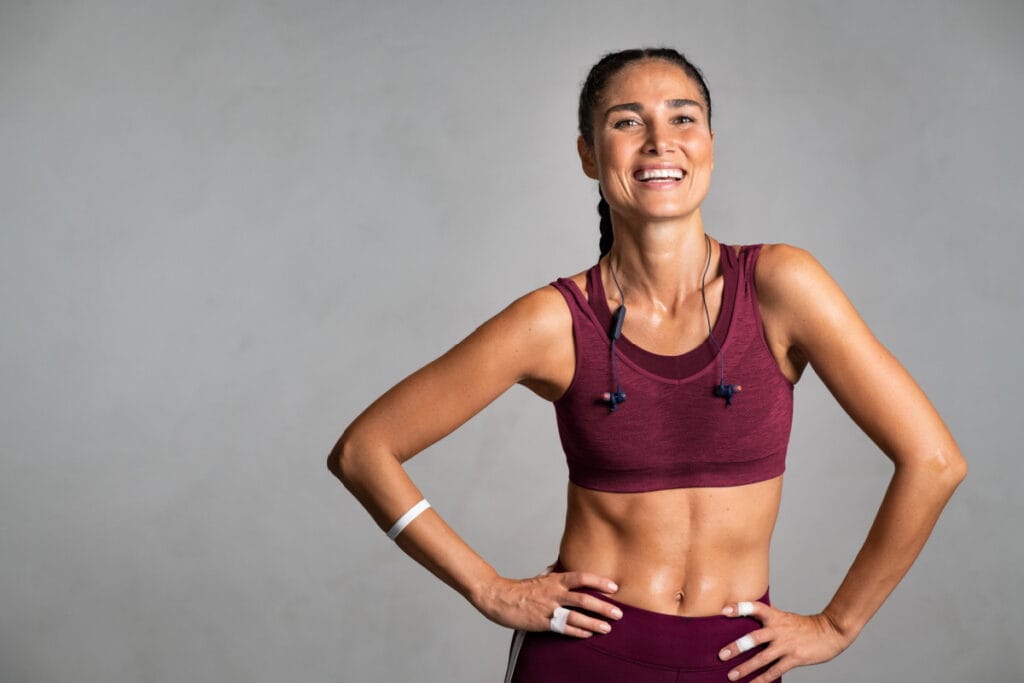Can a Breast Reduction Help Make Me a Better Athlete?

If your breasts feel heavy or impede your movement during training and competition, breast reduction may indeed help you become a better athlete. Though it’s important to make the decision with thoughtful input from physical, chiropractic, and medical specialists, athletic patients generally enjoy easier training and report better performance post-reduction. Let’s explore how and why breast reduction is helpful for athletes, as well as get into post-surgical recovery and training.
Why does breast reduction help athletic performance?
Breasts can be quite heavy compared to the frame of a female athlete. Typically, there is also some degree of breast drooping (ptosis) which causes the weight of the breasts to have an amplified effect on the high thoracic spine and cervical spine. This is due to the lever action of breast tissue freely moving against the center of gravity.
To compensate for the excess weight, the patient’s shoulders will often roll forward, putting a strain on both the postural muscles of the upper back and cervical spine, as well as the muscles that stabilize the shoulder girdle. As this effect moves down the body, the abdominal muscles can become lax while too much tension is carried in the lower back muscles. The pelvis then tilts backward, leading to psoas muscle strain and ineffective mechanical advantage of the gluteal muscles. Gluteal atrophy can then occur. With weakened gluteal muscles and the relationship of the leg to the pelvis in a non-ideal configuration, this can lead to poorly controlled external rotation of the leg during activities such as running.
Thus, from the top-down, overly large breasts can make it challenging for women to exercise effectively and without undue discomfort.
What about sports bras?
Sports bras often prove insufficient for large-breasted athletes. It is not uncommon for these women to wear two sports bras at a time in an attempt to improve support during aggressive exercise. Furthermore, the struggle to find athletic wear that fits and functions is often time-consuming and discouraging. Outside of the gym, finding clothing that matches a large bust size with an athletic figure can also be problematic.

Are my breasts large enough to bother with a reduction?
There is no set definition of what breast size is ideal for an athlete. It is completely up to each woman to decide if her breasts feel too big—after all, you know your body better than anyone else. This is true even if you desire a relatively small reduction in breast tissue compared with larger-breasted patients. If an athlete wears a 32C and she feels her breasts are too heavy or impede movement, it is likely she will greatly enjoy the added freedom a breast reduction can provide.
It’s important to find a surgeon who understands breast reduction for female athletes and doesn’t go strictly “by the book.” Using only technical calculations of a patient’s body surface area versus the amount of breast tissue that can be reduced is largely irrelevant, except when exploring the potential of insurance coverage. This is because insurance-based breast reduction is authorized based on rules that are not at all geared toward female athletes and rely on one-size-fits-all body indicators rather than individual bodies. Referencing these measures can even introduce doubt and lead women to continue suffering instead of moving forward with what would be a highly beneficial procedure for them.
How much time off would I have to take off of training after a breast reduction?
You can return to training after breast reduction sooner than you might after other common breast procedures. The reason for this is that the breasts will be lighter and your incisions will be under less tension. That being said, a good rule of thumb is that the most vigorous exercise should not be resumed until about 12 weeks after your procedure. This is when your healing wounds will have ~80% of the strength that they will eventually have after a year of healing.
How active can I be during my initial recovery?
Initial recovery after breast reduction will include some activity, including light walking for at least 90 minutes per day that should resume starting the day after the procedure. During the second week, light aerobic activity, such as walking uphill, is a great way to avoid deconditioning. As deconditioning begins at 14 days of rest, it is also important to start anti-deconditioning exercises with light weights at this point. At three weeks, exercise can intensify with some limitations relative to the healing breasts. Your cosmetic surgeon should provide specific guidance based on your own personal healing process and the type of athletic activities you hope to resume.
Special attention should also be given to your diet during this period of time. Consume high-protein, low-fat foods supplemented with a reasonable amount of healthy complex carbohydrates. Periodic fasting may also be a helpful tactic for individuals used to consuming many calories in support of a vigorous athletic lifestyle. Meeting with your dietician and doctor to create a thoughtful nutrition plan in advance can help you have an ideal recovery.
How soon after breast reduction can I compete again?
For those contemplating major competitions, I advise having your breast reduction at least two training cycles, or two three-month periods, before the competition. With this schedule, you will be afforded three months of recovery and preparation to return to an optimal training cycle while still having a full three-month training cycle prior to your event.
Another Consideration: The Mental and Emotional Benefits of Breast Reduction for Athletes
In addition to the physical advantages, breast reduction can offer significant mental and emotional benefits for athletes. Many athletes with larger breasts report feeling self-conscious during training or competition due to discomfort or excessive movement. After breast reduction, they often experience a newfound sense of freedom and confidence that enhances their performance. Without the need for multiple sports bras or constant adjustments, they feel more focused and comfortable in their athletic wear, leading to an improved mindset.
This mental shift is particularly impactful in high-intensity sports, where confidence and concentration are key. When athletes feel more streamlined and unrestricted, they often report a boost in motivation and enjoy training even more. If this resonates with you, a breast reduction may offer both physical relief and a more positive athletic experience.
I hope this information proves helpful as you consider the possibility of breast reduction and how it might support your athletic endeavors. If you’d like to discuss the procedure further, I encourage you to contact my office to schedule a personal consultation.
